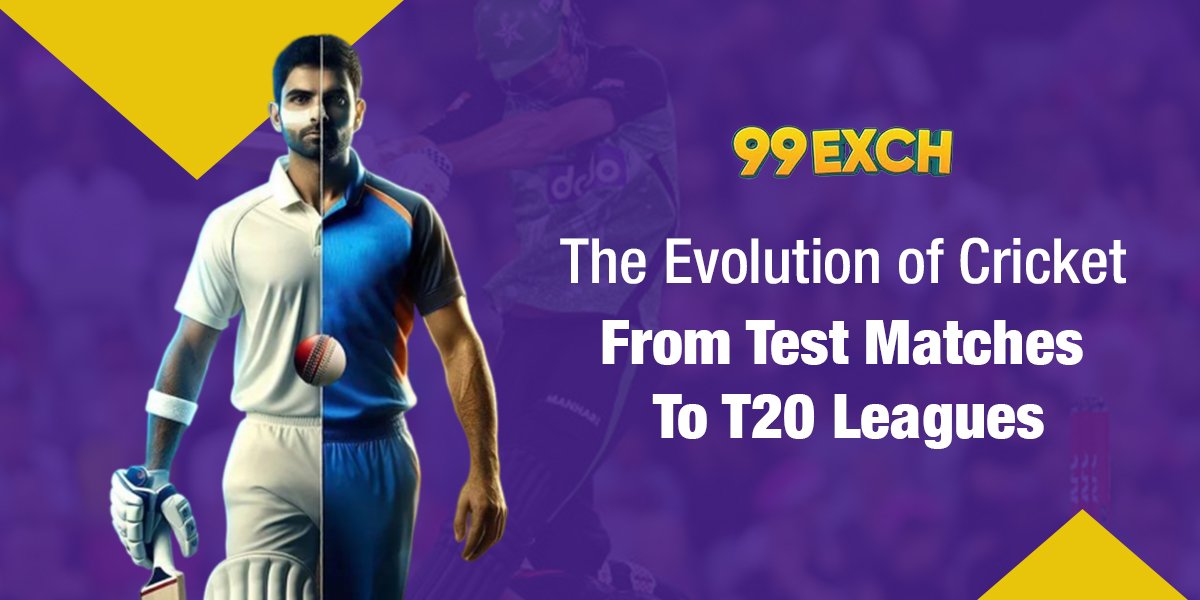The Evolution of Cricket: From Test Matches to T20 Leagues
Cricket is a game with a long history and rich tradition that has evolved incredibly since the 16th century when it was conceived. Cricket’s journey from traditional test matches to T20 leagues filled with drama is an amazing story of adaptability and innovation that reflects larger social and cultural changes. This blog aims to study cricket’s evolution phases through transformation of the 5-day Test format into the exciting world of Twenty20 leagues.
The Origins and Early Development of Cricket
Cricket started in England in the sixteenth century as a rural pastime. By the seventeenth century it was popular among English aristocracy and played on manicured grounds. The first known county match took place in 1709; whilst the Marylebone Cricket Club (MCC), founded in 1787, codified the first official laws for cricket.
Nonetheless, early cricket was characterized by multi-day matches without specified numbers of balls being bowled. It was not until late in the nineteenth century that this stage became identified as Test cricket. The Melbourne Cricket Ground witnessed England versus Australia become its initial officially recognized test match in 1877.
The Golden Age of Test Cricket
Between late 19th and mid-20th centuries, there existed what many people referred to as golden age of test cricket. During this time players such as Sir Don Bradman, W.G Grace and Sir Jack Hobbs were at their peak. The five-day Test cricket for two innings per team became a real test for player’s skills, stamina and tactics.
Test matches became major events which drew crowds while generating significant media interest. The Ashes series between England and Australia began in 1882 becoming one among most famous rivalries across sporting disciplines till date. Test cricket had an abiding appeal because it resembled life itself, with its ups-and-downs requiring perseverance, resourcefulness, hard-nosed decisions mixed with patience & tactical acumen.
The Advent of One-Day Cricket
The 1960s and 1970s witnessed changes in cricket that reflected wider social trends toward faster paced living and instant gratification. In 1963, English county cricket introduced the first limited-overs competition, the Gillette Cup. This new form of play where teams faced a fixed number of overs was introduced to ensure that a match had a result within one day.
One-day internationals (ODIs) debuted in 1971 when a Test between Australia and England was abandoned due to rain and a forty over game was hastily arranged. The success of this match led to the formal adoption of ODIs, and the first Cricket World Cup was held in 1975 in England. ODIs changed the nature of cricket with an emphasis on aggressive batting, innovative bowling and athletic fielding, while matches were shorter and more intense attracting new audience as well as more commercial interest.
The Birth of Twenty20 Cricket
The biggest change that ever occurred in cricket came with the advent of Twenty20 (T20) cricket in the early 2000s. It was England that started T20 cricket in 2003, which was created to fit into a three-hour slot for television and evening entertainment. This results in a fast game characterized by high scores and emphasizes big hitting as well as flamboyant play.
India’s win of the inaugural T20 World Cup in 2007 marked a turning point for the popularity of the format. Further revolutionizing cricket, The Indian Premier League (IPL) began in 2008. These IPL’s are a combination of sports and entertainment, complete with franchises owned by entertainers and business moguls, cheerleaders during matches and glamorous opening ceremonies. It attracted top talent from all over the world which altered how cricket was financed through players signing lucrative contracts.
Effects of T20 Leagues on Global Cricket
There is no doubt that T20 leagues worldwide have had immense effects on cricket. The Big Bash League (BBL) in Australia, Caribbean Premier League(CPL), Pakistan Super League(PSL) among others have taken after IPL bringing together local colors with international stars. Young talents have been given an opportunity to express themselves through these leagues while at the same time enhancing global reach and popularity for cricket.
Nevertheless, there is concern about what will happen with Test and ODI formats now that T20 has emerged. In particular, the shorter versions such as T20 provide higher earnings plus media exposure leading to worries they might overshadow longer traditional formats. A few players now specialize just on playing T/2Ogames , thus potentially compromising the depth and quality of test matches.
Striking Balance Between Tradition And Innovation
Cricket governing bodies like ICC(International Cricket Council )have struggled with balancing between highly held traditions about this sport on one side while trying to incorporate innovativeness on another. This is seen in initiatives like World test championship that was introduced in 2019 to make Test cricket more interesting and relevant to the modern world. On the other hand, ODI cricket has witnessed powerplays being introduced and day night matches being played just to keep it active.
Changing with the times, Cricket’s evolution has demonstrated its flexibility and adaptability. While formats have expanded, the game’s essence—the contest between bat and ball—has remained constant. Traditionalists may still honor Test cricket for its emphasis on skill and strategy while T20 cricket attracts new followers with its explosive action.
Conclusion
Over time, Cricket has transformed itself into a sport that is very much alive from the slow tempo of Test matches to the fast-paced nature of T20 leagues, always trying to remain appealing and up-to-date. Each format adds something different but equally important when it comes to making what this sport truly embodies. Platforms like 99 exchange have also contributed to this evolution by providing a dynamic space for fans and enthusiasts to engage with the sport. The interplay between tradition and innovation will continue as cricket moves forward; thus, keeping it at the heart of fans globally while preserving its heritage as well as embracing change.




